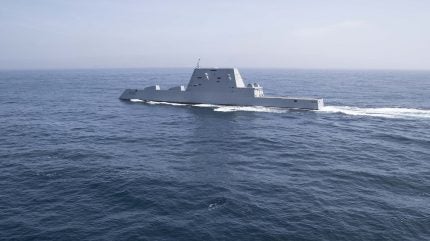
US shipbuilder HII announced on 9 April that its Mission Technologies division had been awarded a $74m contract to research and develop enhanced capabilities for the Mk41 and Mk57 vertical launching systems (VLS) onboard US Navy surface vessels.
The task order, administered by the Naval Surface Warfare Center (NSWC) Port Hueneme Division, also applies to associated naval surface weapon systems, combat systems and sensors employed within the US Navy.
HII’s statement of work includes outfitting the first Zumwalt-class destroyer, the USS Michael Monsoor (DDG 1001), with the Mk57 vertical launch system universal canister electronics unit. The unit, developed by HII, allows the firing of any naval missile from any VLS cell on Zumwalt-class ships.
The company stated that it will also “leverage industry capabilities to support rapid design prototyping, technological improvements and engineering requirements associated with obsolescence issues”.
HII was awarded the recompeted task order under the US Department of Defense’s Information Analysis Center Multiple Award Contract vehicle and will last for a five-year term.
According to HII, most of the work will be performed in Syracuse, New York, and Arlington, Virginia. HII’s support to NSWC Port Hueneme is an extension of work performed under a previous contract awarded in 2021.
Zumwalt-class DDGs
The US Navy’s Zumwalt-class guided missile destroyers (DDGs) are cruiser-sized naval surface vessels intended to perform the full spectrum of surface warfare operations, particularly air defence. Planned to be a class of up to 12 vessels, the build of the Zumwalt DDGs was curtailed to just three vessels in favour of the development of the Flight III Arleigh Burke-class destroyers.
Unique amongst the world’s naval warships, the Zumwalt class design uses a ‘tumblehome’ hull form, in which the hull slopes inward from above the waterline. This significantly reduces the radar cross-section since such a slope returns a much less defined radar image rather than a more hard-angled hull form.
The Mk57 VLS installed on the Zumwalt class is a solution based on the peripheral vertical launch system (PVLS), consisting of 20 four-cell PVLS situated around the perimeter of the deck, rather than the usual centrally located VLS. This is intended to reduce the ship’s vulnerability to a single hit.
The advanced vertical launch system (AVLS) that forms the basis of the PVLS was developed by BAE Systems Land and Armaments and Raytheon and designated the Mk57 system.
Missile systems include Tactical Tomahawk, also known as the Block V(a/b)/Maritime Strike Tomahawk, which is the latest variant of the legacy cruise missile, marinised for anti-ship performance as well as maintaining a land attack capability. Other missile carried include the Standard Missile (SM) 3 and the Evolved Sea Sparrow (ESSM) for air defence.
Separate to the AVLS is the forthcoming Conventional Prompt Strike (CPS) system – a hypersonic missile structure – which is being integrated onto the Zumwalt class by HII, in replacement of the 155mm twin main guns originally fitted.







